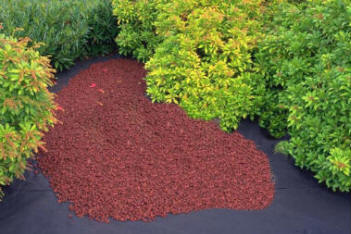Landscape Fabric
Landscape Fabric
The Pests That Are Weeds.

Weeds have long been the nemesis of gardeners all around the world and whether
you're a practiced gardener or a complete beginner there are always times when
you need to do something about a weed infestation within your own back yard.
Unused soil is a breeding ground for almost every type of weed that is looking
for a home, so if you have a patch of earth laid out for planting at a later
date this patch will soon become overgrown with unwanted weeds. Once the weeds
start to grow, even pulling them up inevitably leaves roots and new weeds will
start to grown in their place almost as soon as you've cleared the area.
Some Methods To Beat Weeds.
There are a number of methods that people have attempted to use for landscape
fabric over the years and they show varying degrees of success when it comes to
destroying weeds. Black plastic lining offers excellent protection from weeds
growing through but it will eventually damage the soil because of a lack of sun
light and water. Natural mulches such as bark are also used and while these
still allow water to drain through to the soil they will decompose. This
decomposing mass will inevitably attract weeds itself making the mulch not only
useless but also more damaging than having no protection whatsoever.
The Best Method To Help Beat Weeds.
An alternative is available to these methods in the shape of landscape fabrics.
These fabrics prevent weeds establishing in the area but they also allow
everything your soil needs to penetrate. This combination means you are able to
effectively prevent weeds from growing while keeping the soil healthy for any
future planting. The fabric is laid in a similar way to the black plastic that
is sometimes used and most of the work will be completed when preparing the area
beforehand.
Smooth The Ground And Remove The Debris.
As with any fabric that is to be used as a liner it is imperative that you fit
the landscape fabric on ground that is smooth and flat. Remove any debris and
rake any soil that has lumps. If you place the fabric on top of anything sharp
there is a very real chance that the fabric will become damaged and torn
allowing weeds to grow through the fabric. The use of a hoe will also enable you
to remove any weeds that have already started growing. Once you have smoothed
the area then it is time to lay the fabric.
Overlapping Two Sheets Of Fabric.
If you need to use more than one sheet of landscape fabric then you should
overlap the two by a good few inches. Most products recommend two to three
inches but if you want to be on the safe side then leave a five or six inch
overlap. Lay the fabric loosely with no covering so you can ensure that you are
placing it correctly and you have enough fabric to cover the area in question.
If necessary weigh the fabric down with heavy objects, although ensure that you
don't use anything that may rip the fabric and compromise the integrity.
Securing The Landscape Fabric To The Ground.
Use fabric pins to securely fasten the landscape fabric to the ground. They
should slide through the fabric fairly easily and will hold the fabric in place.
Pin the fabric down around the edges and through the overlap. Once you have done
this you should place an inch thick layer of mulch on top of the fabric. This
adds to the level of protection that your weed resistance offers. Next you will
need to cut into the fabric to allow for planting.
Finishing The Job.
Use a pair of scissors and cut two slits in a cross shape. You should keep the
amount of incisions to a minimum and always use slashes instead of large holes.
Once you have the incision, lift the flaps and plant your shrub or plant in
place. Then fold the flaps back over again so that they are tightly placed
against the trunk of the shrub. Then place the mulch back on the fabric taking
care to ensure that the mulch does not touch too much of the trunk because this
can damage the shrub. Once you've completed this, everything is finished and it
is time to sit back and enjoy your new plant bed.
© 2003-2024 LawnCareBusiness.comm